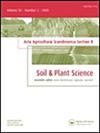Production and nutrient composition of forage legume fractions produced by juicing and leaf stripping
IF 1.8
4区 农林科学
Q2 AGRONOMY
Acta Agriculturae Scandinavica Section B-Soil and Plant Science
Pub Date : 2023-10-25
DOI:10.1080/09064710.2023.2265147
引用次数: 0
Abstract
The large-scale import of soybean products into the EU decreases the self-sufficiency of livestock production. The fractionation of grassland forage crops presents an opportunity to locally produce protein-rich feed for monogastrics. Two promising fractionation methods, twin-screw press juicing and leaf stripping, were evaluated in parallel in field experiments established in Norway and Sweden to compare the nutrient composition and yield of the resulting biorefined and residual fractions. The clearest delineation between the methods was in the ash-free neutral detergent fibre (aNDFom) concentration, with juicing producing a biorefined fraction with a lower aNDFom than leaf stripping. Variability in the allocation of crude protein (CP) and biomass to the biorefined fractions occurred in both methods between cuts and locations and is likely due to differing stand characteristics and inconsistency in machine functionality. Additional work is needed to understand how characteristics such as stand density, botanical composition, and plant phenological stage impact each fractionation method’s ability to allocate protein, fibre, and biomass into the resulting fractions. Future studies should focus particularly on determining standardised settings for leaf stripping machinery based on a range of stand characteristics to ensure consistency in the yield and nutrient composition of the resulting fractions.豆科草料榨汁和剥叶生产的产量及营养成分
欧盟大规模进口大豆产品降低了畜牧业生产的自给自足。草原饲料作物的分种为在当地生产富含蛋白质的饲料提供了机会。在挪威和瑞典建立的田间试验中,对两种很有前途的分离方法——双螺旋榨汁和叶片剥离进行了平行评估,以比较所得生物精制馏分和残留馏分的营养成分和产量。两种方法之间最明显的区别是无灰中性洗涤纤维(andform)的浓度,榨汁产生的生物精制部分的andform低于叶片剥离。在两种方法中,粗蛋白质(CP)和生物量分配到生物精炼部分的差异发生在切割和位置之间,可能是由于不同的林分特征和机器功能的不一致。还需要进一步的工作来了解林分密度、植物组成和植物物候阶段等特征如何影响每种分馏方法将蛋白质、纤维和生物量分配到所得分馏物中的能力。未来的研究应特别侧重于根据一系列林分特征确定剥叶机械的标准化设置,以确保所得馏分的产量和营养成分的一致性。
本文章由计算机程序翻译,如有差异,请以英文原文为准。
求助全文
约1分钟内获得全文
求助全文
来源期刊
CiteScore
4.40
自引率
0.00%
发文量
56
审稿时长
2.3 months
期刊介绍:
Acta Agriculturæ Scandinavica Section B publishes original research in applied soil and plant science with special attention given to to crop production in agri- and horticultural systems. We welcome manuscripts dealing with:
Climate smart and sustainable crop production systems
Water and nutrient efficiency
Soil conservation and productivity
Precise agriculture systems
Applications of bio- and nanotechnology
Digitalisation and robotics
Soil-plant interactions
Acta Agriculturæ Scandinavica, Section B – Soil & Plant Science forms part of a series of titles published on behalf of the Nordic Association of Agricultural Science (NJF). The series also includes Section A - Animal Science .

 求助内容:
求助内容: 应助结果提醒方式:
应助结果提醒方式:


